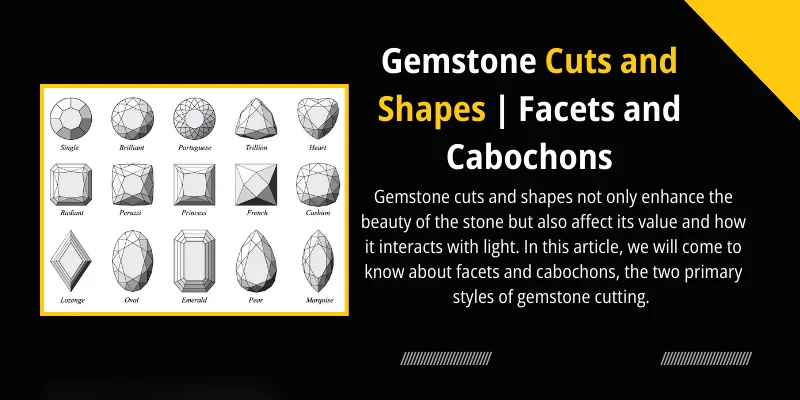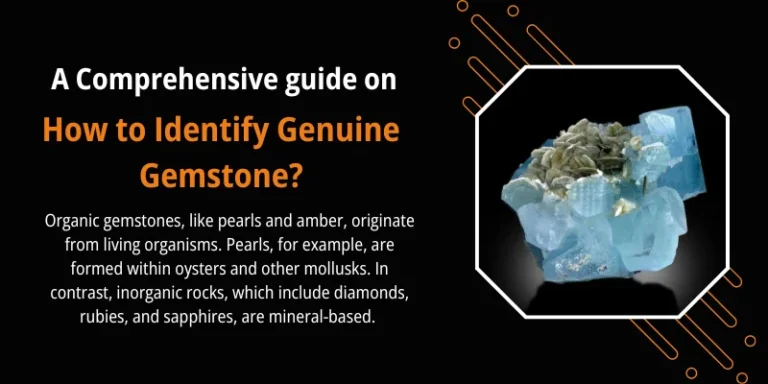Gemstone Cuts and Shapes | Facets and Cabochons

Have you ever wondered why gemstones come in so many different shapes and cuts? From the sparkling brilliance of a diamond to the smooth, polished surface of an opal, the art of shaping gemstones is truly fascinating.
Gemstone cuts and shapes not only enhance the beauty of the stone but also affect its value and how it interacts with light. In this article, we will come to know about facets and cabochons, the two primary styles of gemstone cutting. By understanding these techniques, you’ll gain a greater appreciation for the craftsmanship that goes into every precious gem.
What are Facets?
Facets are small, flat surfaces cut into a gemstone to enhance its brilliance and sparkle. When light enters a faceted gemstone, it is reflected off these surfaces, creating the dazzling effect we often associate with precious stones.
Faceted cuts are commonly used for transparent stones like diamonds, sapphires, and emeralds. The most popular faceted cut is the round brilliant cut, which maximizes the stone’s sparkle by using 58 facets.

Other well-known faceted cuts include the princess cut, emerald cut, and oval cut. Each cut has its unique pattern of facets that can highlight different aspects of the gemstone, such as its color or clarity.
Understanding Cabochons
Cabochons are gemstones that have been shaped and polished instead of faceted. They have a smooth, rounded surface and are often used for opaque or translucent stones like opals, turquoise, and moonstones.
The cabochon cut is one of the oldest gemstone cuts, dating back thousands of years. This cut is particularly popular for stones with unique patterns or inclusions, as the smooth surface allows these features to be seen clearly.

Cabochons are typically cut into simple shapes like circles and ovals, but they can also be found in more elaborate forms, depending on the stone’s natural characteristics.
Popular Non Faceted Shapes
Cabochons come in a variety of shapes, with the most common being round and oval. These shapes are favoured because they complement the natural form of many gemstones, minimizing waste during the cutting process.
Other popular cabochon shapes include teardrop, marquise, and heart. Each shape can enhance the gemstone’s inherent beauty, showcasing its unique patterns and colors.
For example, a teardrop cabochon might highlight the flowing patterns in an opal, while a heart-shaped cabochon could emphasize the rich color of a ruby.
How Cuts Affect Value
The cut of a gemstone significantly impacts its value. A well-cut gemstone will reflect light beautifully, enhancing its color and brilliance. For faceted stones, the quality of the cut can make a difference in how much the gemstone sparkles.
In contrast, the appeal of a cabochon lies in its smooth surface and the way it showcases the stone’s natural features. Gemstones with high-quality cuts, whether faceted or cabochon, are generally more valuable because they display the stone’s best attributes.
Therefore, the precision and artistry involved in cutting a gemstone play a crucial role in determining its worth.
Popular Gemstone Cuts Today
Gemstone cuts play a crucial role in enhancing the beauty, brilliance, and overall appeal of precious stones. Here are some of the most popular gemstone cuts in the market today:
Round Brilliant Cut

The round brilliant cut is the most popular and widely used gemstone cut, especially for diamonds. This cut features 58 facets, which maximize the stone’s sparkle and brilliance. It is designed to reflect the maximum amount of light, making it the go-to choice for engagement rings and other fine jewelry.
Princess Cut

The princess cut is a square-shaped cut with sharp, angular corners. It is the second most popular cut after the round brilliant. This cut is known for its modern and elegant appearance, offering excellent brilliance and fire. The princess cut is often used in engagement rings and earrings.
Emerald Cut

The emerald cut is a rectangular shape with step-cut facets that create a hall-of-mirrors effect. This cut emphasizes the clarity and color of the gemstone rather than its brilliance. It is a popular choice for larger gemstones and is often used for emeralds, hence the name.
Oval Cut

The oval cut combines the brilliance of the round cut with an elongated shape, making the gemstone appear larger. This cut is versatile and can be used for various types of gemstones, including diamonds, sapphires, and rubies. The oval cut is favored for its elegant and sophisticated look.
Pear Cut

The pear cut, also known as the teardrop cut, is a combination of the round and marquise cuts. It has a rounded end on one side and a pointed end on the other. This cut is popular for pendants and earrings, as it creates a unique and eye-catching shape.
Marquise-Cut

The marquise cut is an elongated shape with pointed ends, designed to maximize the carat weight of the gemstone. This cut creates the illusion of a larger stone and is often used for rings and necklaces. The marquise cut is known for its regal and dramatic appearance.
Cushion Cut

The cushion cut is a square or rectangular shape with rounded corners and larger facets. This cut combines a vintage feel with modern brilliance, making it a popular choice for various types of jewelry. The cushion cut is often used for diamonds and colored gemstones.
Asscher Cut

The Asscher cut is a square shape with step-cut facets and cropped corners. Developed in the early 20th century, this cut is known for its Art Deco style and vintage appeal. The Asscher cut emphasizes the clarity and depth of the gemstone, making it a favourite for antique-style jewellery.
Radiant Cut

The radiant cut combines the elegance of the emerald cut with the brilliance of the round cut. It features a rectangular or square shape with trimmed corners and numerous facets that enhance the stone’s sparkle. The radiant cut is versatile and can be used for both diamonds and colored gemstones.
Heart Cut
The heart cut is a romantic and unique shape that resembles a heart. This cut is often used for pendants and rings, symbolizing love and affection. The heart cut requires precise craftsmanship to ensure symmetry and brilliance.

These popular gemstone cuts each offer unique characteristics that enhance the beauty and value of the stones. Whether you prefer the classic brilliance of the round cut or the vintage charm of the Asscher cut, there is a perfect cut for every gemstone and occasion.
shop Now
Mini but mighty, these crystal hearts pack a big punch – Shop Now!
Conclusion
In the world of gemstones, the cut and shape are paramount. Understanding the difference between faceted cuts and cabochon cuts can deepen your appreciation for these natural wonders. On the other hand, cabochons, with their smooth, rounded surfaces, are ideal for showcasing the unique patterns and colors of opaque or translucent stones.
Whether you prefer the glittering facets of a diamond or the smooth elegance of an opal cabochon, the world of gemstone cuts and shapes has something for everyone. Each cut and shape brings out different qualities in a gemstone, making each piece unique.




